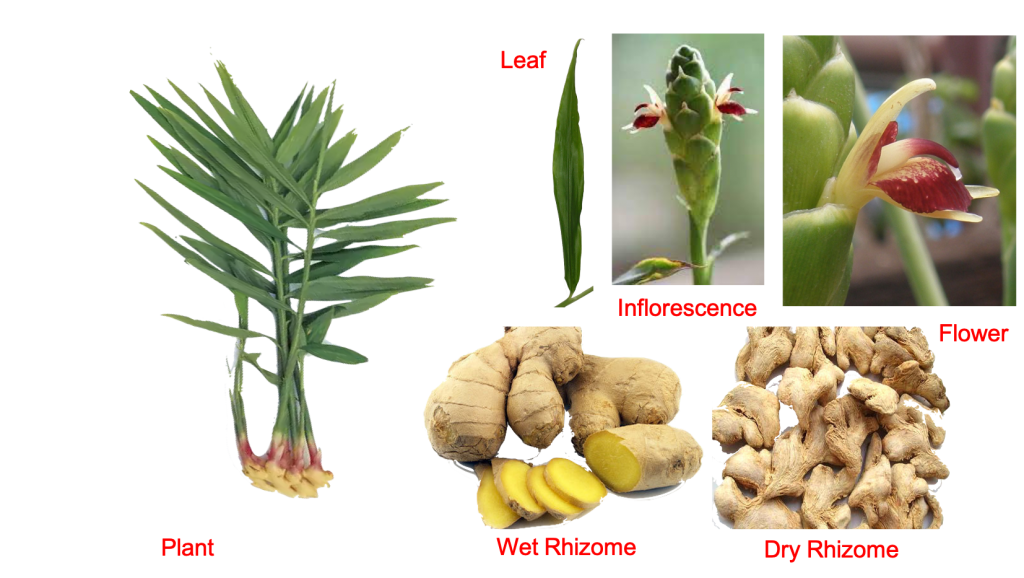ARDRAKA/SHUNTI
- Home / DRAVYAGUNA (AYURVEDIC PHARMACOLOGY) / / KNOW ABOUT MEDICINAL PLANTS / / AYURVEDIC MEDICINAL PLANTS /
- ARDRAKA/SHUNTI
The plant ARDRAKA is a herb that has found its place not only in our kitchen but also in the books of medicine too. It is the most used spice in our kitchen but also equally used medicine especially in the traditional systems like Ayurveda. The plant’s rhizome is used for different purposes either as spice or medicine. The name ‘Ardraka‘ is the one that denotes the fresh rhizome while the name ‘Shunti‘ denotes the dried rhizome of the same plant. Both the wet and dried varieties have some difference in their properties as per Ayurveda. Hence, their uses are also in different conditions too. The details of the same are being explained in successive parts of the page. The botanical or Scientific name of the plant is Zingiber officinale Roscoe. The word Zingiber is a latin word or name for ginger which was used as spice right from the past. The word is actually derived from the “PRAKRIT” word Sringabera which is inturn derived from the Sanskrit word Shringavera itself. The word officinale is the word that explains the rhizome is officially recognised as Ginger.
PLANT DETAILS
BOTANICAL NAME
Zingiber officinale Roscoe
FAMILY
Zingiberaceae
NOMENCLATURE
VERNACULAR NAMES
- Kannada – Shunti
- Malayalam – Chukka
- Tamil – Kshukku
- Telugu – Shonti
- Hindi – Adrak
- English – Ginger
SANSKRIT SYNONYMS
- आर्द्रक (Ardraka) – Fresh juicy state of ginger
- शुण्ठी (Shunti) – That which stops the Kapha.
- ऊषण (Ushana) – Has a hot potency
- नागर (नागर) – the drug is a great medicament.
- विश्वभेषज (Vishwabheshaja) – A universal medicine
- शृंगवेर (Shringavera) – The rhizome resembles with that of horn.
- महौषध (Mahaushadha) – A medicament with utmost benefits.
SAMHITA CLASSIFICATION
- Charaka Samhita – तृप्तिघ्न (Triptighna), अर्शोघ्न (Arshoghna), दीपनैय (Deepaneeya), शूलप्रशमन (Shulaprashamana) and तृष्णनिग्रहण (Trishnanigrahana).
- Sushruta Samhita – त्रिकटु (Trikatu) and पिप्पल्यादि (Pippalyadi)
NIGHANTU CLASSIFICATION
- Dhanvantari Nighantu – Shatapushpadi Varga
- Bhavaprakasha Nighantu – Hareetakyadi Varga, Panchakola and Shadushana
- Raja Nighantu – Pippalyadi Varga
- Kaiyadeva Nighantu – Aushadhi Varga
BRIEF MORPHOLOGY
The plant is a perennial erect herb with tuberous rhizomes. The rhizomes and the root stalk is horizontal, aromatic, erect with leafy stems that are elongated upto 150cms. The leaves are narrow, sessile, alternate, acuminate and is upto 50cm in length. The base surrounds the stem upto 20 cms and has a glabrous ligule. The inflorescence is spike that terminate the leafy branch or stem and grows upto 3 inches long. The flowers are greenish yellow or yellowish with dark-purple lip along with yellow spots. The buds are usually in white or pink colour present in clusters. The rhizome is green in its fresh state and is known as Ardraka while the dry state which is slight grey in colour is known as Shunti.
PHARMACOGNOSY OF OFFICIAL PART
MACROSCOPY
YET TO BE COMPILED
MICROSCOPY
YET TO BE COMPILED
PART USED AND POSOLOGY
PART USED
कन्द (Rhizome)
DOSE
चूर्ण (Powder) – 1 to 2 gms स्वरस (Juice) – 2-5ml, फाण्ट (Infusion) – 8-10ml.
PHYTOCHEMISTRY
The rhizome contains a volatile oil that is having a yellow colour. It also contains the principles like gignerin, gingerol, resins, starch, zingerone, etc. While the dry ginger will have Shogals which is formed from the gingerols on heating or drying and storage through the process of acidity.
रसपञ्चक कर्म PROPERTIES AND USES AS PER AYURVEDA
गुण (Properties)
- रस (Rasa) – कटु (Katu)
- गुण (Guna) – लघु (Laghu), रूक्ष (Ruksha), तीक्ष्ण (Teekshna) (ARDRAKA); लघु (Laghu), स्निग्ध (Snigdha) (SHUNTI)
- वीर्य (Veerya) – उष्ण (Ushna)
- विपाक (Vipaka) – मधुर (Madhura)
- प्रभाव – None
कर्म & प्रयोग (Action & Indications)
- दोषकर्म (Doshakarma) – कफवातशामक (Kaphavatashamaka)
- धातुकर्म & मलकर्म (Dhatukarma and Malakarma) – Main actions – भेदन, पाचन, रोचन, वृष्य, स्वर्य, दीपन, शूलप्रशमन, ग्राहि (Bhedana, Pachana, Rochana, Vrushya, Swarya, Dipana, Shulaprashamana, Grahi)
- Other Actions – कासघ्न, वातानुलोमन, अर्शोघ्न, रक्तशोधक, हृदयोत्तेजक, शोथहर, वेदनास्थापन, शीतप्रशमन, बल्य (Kasaghna, Vatanulomana, Arshoghna, Raktashodhaka, Hridyaottejaka, Shothahara, Vedanasthapana, Sheetaprashamana, Balya)
- प्रयोग (Prayoga) – Mainly विबन्ध, आनाह, शूल, आमवात, अर्श, वमी, हिध्म, आमदोष (Vibandha, Anaha, Shula, Amavata, Arsha, Vami, Hidma, Amadosha) also useful in हृद्रोग, शोफ, श्लीपद, उदर, श्वास, कास, etc (Hridroga, Shopha, Shleepada, Udara, Shwasa, Kasa, etc)
AYURVEDIC FORMULATIONS
CLASSICAL
- त्रिकटु
- आर्द्रकखण्ड
- पञ्चसमचूर्ण
- समशर्करचूर्ण
- महारास्नादि क्वाथ
- शुण्ठी घृत
- सौभाग्य शुण्ठी पाक
- All formulations where Triphala is a ingredient
PROPRIETARY
- Oushadhi Cough Syrup
- Bhavana Shunti
AGRONOMY
ENVIRONMENT
The plant requires warm and humid climate upto an altitude of 1500mts. It can grow with moderate rainfall. The cool and dry climate is best for rhizome development while requires a moderate rainfall during the sowing time.
CULTIVATION
Ginger prefers sandy loam, clayey loam, red loam or laterite loam soil. But a well drained, friable, deep loamy soil, rich in humus is ideal. Still it is not recommended to grow the plant every year continuously. The best time for planting is during the 2nd half of May after the summer showers or even during the month of February or early March which gives higher yields. But there should be sufficient moisture in the soil. The rhizome seed (rhizome cutting with buds) are to be of 2.5 to 5cm in length with two good buds. As many as 3000 seeds per acre can be sown. Before planting the seeds are recommended to be dipped in cow’s urine for 30 minutes. On planting it needs heavy manuring with 3 tones of compost or rotten cowdung per acre as the base manure and an additional manure of 800kg neem cake per acre is also required for the same.
HARVESTING
The crop is ready to harvest at 8 to 10 months or 240 days. Can be harvested in 180 days but for drying it is recommended to harvest after maturity. Maturity is denoted by drying of leaves and turning into yellow colour. For harvesting, the irrigation is cut off and the crop is kept as it is for 1 month. Then the rhizome is taken by digging it out with a digging fork or spade. The dried leaves, soil and roots are separated. The most needed content for assessing the maturity is pungent level, volatile oil level and fibre contents. The average yield of the rhizome is 6 to 10 tons per acre while 80 to 85% of the weight is lost on drying.
STORAGE
The skin of the fresh ginger are scrapped with sharp bamboo pieces, washed and dried in sun for 3 to 4 days. It is then again immersed in water and the remaining skin is also removed and again dried. Bleaching of ginger is done by dipping it in a lime slurry and again sun-dried. The process is repeated till the rhizomes become uniformly white. Dried rhizomes can be stored upto 2 years.
VARIETIES AND SUBSTITUTES OR ADULTERANTS
VARIETIES
Marketed forms of Ginger – Raw Ginger, Dry Ginger, Bleached dry ginger, Giner powder, Ginger oil, etc which are different forms of the rhizome.
ADULTERANTS
NO KNOWN ADULTERANTS
SUBSTITUTES
NO KNOWN SUBSTITUTES
TOXICITY
TOXIC SYMPTOMS
- As such there is no proved toxicity of the plant.
ANTIDOTE
- Not Applicable as such.
शोधन or PURIFICATION METHOD
- NOT NECESSARY
THERAPEUTIC USES
EXTERNAL USES –
The paste of rhizome is applied over swollen joints to treat conditions like Rheumatoid Arthritis where it helps to remove the stiffness of the joint. Even the use of the oil after processing it with the rhizome is useful in reduction of pain and also chills or hypothermia. The paste of the rhizome is applied locally to treat headache and toothache. The powder is rubbed on the extremities to improve blood circulation while treating conditions like Cholera, etc.
INTERNAL USES –
The fresh ginger is advised with salt and chewed before food to improve appetite. It also helps one to relish the food as it enhances taste and also removes the bad taste of mouth by clearing the tongue. Infusions of the rhizome powder will help in relieving indigestion and also certain respiratory disorders like cough, dyspnea, chest pain, etc. Chewing the fresh pieces or even the dry pieces will result in relief of flatulence, dyspepsia, constipation and vomiting.
CONTRA-INDICATIONS
Even though it is a common spice in many of our kitchens, it is having a set of contra-indications where it may lead to mild or moderate complications. It is unadvisable to be taken by those who are suffering from medical conditions that have resulted due to Pitta Dosha like Pandu, Raktapitta, Mutrakricchra, Daha and Jwara which are equated to Anaemia, Bleeding disorders, Scanty or burning micturition, Dysestheisa and other similar conditions. It may result in rashes if the person is hypersensitive (Pitta Prakriti in this case), cause heartburn if used in excess.
CONTROVERSY (IF PRESENT)
YET TO BE COMPILED
LIST OF RESEARCH STUDIES
- Mashhadi, N. S., Ghiasvand, R., Askari, G., Hariri, M., Darvishi, L., & Mofid, M. R. (2013). Anti-oxidative and anti-inflammatory effects of ginger in health and physical activity: review of current evidence. International journal of preventive medicine, 4(Suppl 1), S36–S42.
- Mao, Q. Q., Xu, X. Y., Cao, S. Y., Gan, R. Y., Corke, H., Beta, T., & Li, H. B. (2019). Bioactive Compounds and Bioactivities of Ginger (Zingiber officinale Roscoe). Foods (Basel, Switzerland), 8(6), 185. https://doi.org/10.3390/foods8060185
- Huanfung Liu, Chelsea D Specht et al. (2020). Morphological Anatomy of Leaf and Rhizome in Zingiber officinale Roscoe, with emphasis on Secretory Structures. HortScience, Vol 55(2), 206-207. https://doi.org/10.21273/HORTSCI14555-19
The video on Ardraka emphasises on the various aspects of the plant especially with respect to its cultivation and its characteristics for identification such that they are preserved for the future generations.



